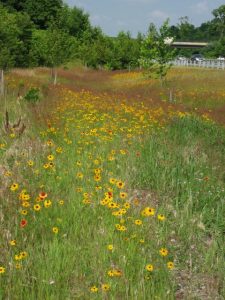
Photo: Vegetated Swale in North Carolina
T.S. Elliot is quoted as saying that humankind cannot bear too much reality. This is certainly true for the stormwater sector when it comes to paying for stormwater retrofits to comply with MS4 permits and TMDLs. Where will the money come from? The taxpayer. The message of the magnitude of this unfunded mandate needs more publicity before the liability becomes much larger. We need to have a public discussion about the total costs of the program, and how we are going to pay for it.
Dominique Lueckenhoff of the USEPA and Seth Brown, Principal of Storm and Stream, LLC, have written a short primer for Bloomberg BNA’s Water Law & Policy Monitor, “Financing Integrated Green Stormwater Infrastructure for Community Health and Resiliency – Getting the Best Deal for the Money” (October 13, 2016). Lueckenhoff and Brown point out that as our flood control infrastructure ages, we are asking more of it in terms of resiliency and to help improve water quality. Things they point out, need to be addressed to keep development sustainable.
What is not sustainable is the funding deficit for stormwater programs. Chronically underfunded since the mid-1990’s, the funding gap will approach a crisis level in the next decade. The authors do an excellent job of explaining the virtues of green infrastructure, and then detailing the current tools to pay for it. Public funding options range from the general fund to stormwater utilities, the State Revolving Fund and Bonds, but the more engaging options described are private: private equity, green bonds and social impact bonds. A hybrid option is explored as well, the community based public private partnership (CBP3). The authors describe the CBP3 as, “A new model for efficient GSI enhanced project delivery. The CBP3 platform differs from the traditional P3 framework by working through a ‘‘CBP3 entity’’ that is supported by both the private and the public entities with the goal of addressing the needs and goals of the community as the top priority rather than maximizing profits for the private entity alone.”
We need to make progress on financing of GI. Implementing pilot projects using creative funding alternatives is a good first step. What could be more appealing than ‘Getting the Best Deal for the Money?
Scott Taylor, P.E., D.WRE is the current Vice Chair of the National Municipal Stormwater Alliance, a new 501c3 formed to champion MS4 issues and programs at the national level. Scott reviews a Bloomberg News Insights article titled, “Financing Integrated Green Stormwater Infrastructure for Community Health and Resiliency – Getting the Best Deal for the Money.”



